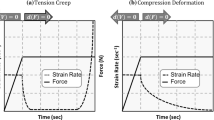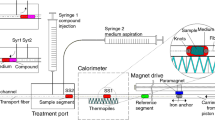A resistive SQUID may be used to measure heat current. We call an RSQUID used in such a way an RSqUID: It acts as a heat-current to frequency (q−f) converter of sensitivity β=f/q. Two methods of heat capacity measurement by the use of an RSqUID are described. In the direct method the number of cycles of oscillation when the temperature of the RSqUID and specimen is changed by δT is counted. The measured heat capacity C m (to be corrected for the addenda) is given by Cm=n/(βΔT). In the step method the specimen and heater together are separated from the RSqUID by a thermal resistance R. The RSqUID is biased to a frequency f 1. The heater is switched on and a number of cycles is obtained which represents the amount of heat required to bring the specimen to equilibrium in the new steady state, in which f=f2+δf. By this method the quantity Cm=n/(Rδf) is obtained. In both methods the heat current is integrated by counting to obtain an amount of heat Q=n/β, which may thus be measured very precisely if the number of cycles is sufficiently large [and β(T) calibrated accurately]. The first RSqUID constructed for heat capacity measurement is described. In this RSqUID the high thermal resistance of press contacts has been avoided and soft solder as well as niobium used for superconducting material. The sensitivity β varied from 0.8 to 0.4 Hz nW−1 between 2 and 7 K. The results of measurements made between 2 and 7K by the step method with this RSqUID in a rather unsophisticated cryostat achieved a relative accuracy of ~0.1% with samples of mass about 1 g. Results of measurements made on samples of pure copper and indium are described.
Similar content being viewed by others
References
J. E. Zimmerman, J. A. Cowen, and A. H. Silver, Appl. Phys. Lett. 9, 353 (1966).
R. A. Kamper and J. E. Zimmerman, J. Appl. Phys. 42, 132 (1971).
J. G. Park, Superconductor Applications, SQUIDs and Machines, B. B. Schwarz and S. Foner, eds. (Plenum, New York, 1976), p. 415.
J. G. Park, in Superconducting Interference Devices and Their Applications (Walter de Gruyter, Berlin, 1977), p. 277.
J. G. Park and A. W. Vaidya, J. Phys. (Paris) 39, C6–1228 (1978).
B. D. Josephson, Adv. Phys. 14, 419 (1965).
J. G. Park, J. Phys. F: Metal Phys. 4, 2239 (1974).
J. G. Park and J. P. Kendall, in Proc. 14th Int. Conf. Low Temp Phys. (North-Holland, Amsterdam, 1975), Vol. 3, p. 1645.
J. T. Harding and J. E. Zimmerman, J. Appl. Phys. 41, 1581 (1970).
A. H. Silver, J. E. Zimmerman, and R. A. Kamper, Appl. Phys. Lett. 11, 209 (1967).
J. G. Park, D. E. Farrell, and J. P. Kendall, J. Phys. F: Metal Phys. 4, 2169 (1973).
R. J. Soulen and M. Marshak, in Proc. Conf. Appl. Superconductivity, Annapolis, Maryland (IEEE, New York, 1972), p. 588.
F. J. Morin and J. P. Maita, Phys. Rev. 129, 1115 (1963).
R. Bachmann, F. J. DiSalvo, T. H. Geballe, R. L. Greene, R. E. Howard, C. N. King, H. C. Kirsch, K. N. Lee, R. E. Schwall, H. U. Thomas, and R. B. Zubeck, Rev. Sci. Instr. 43, 205 (1972).
R. A. Kamper, in Superconductor Applications, SQUIDs and Machines, B. B. Schwarz and S. Foner, eds. (Plenum, New York, 1976), p. 189.
R. Berman and C. F. Mate, Nature 182, 1661 (1958).
D. K. C. McDonald, W. B. Pearson, and I. M. Templeton, Proc. Roy. Soc. A 266, 161 (1962).
A. Kjekshus and W. B. Pearson, Can. J. Phys. 40, 98 (1962).
P. J. Tainsh and G. K. White, J. Phys. Chem. Solids 23, 1329 (1962).
J. C. Holste, T. C. Cetas, and C. A. Swenson, Rev. Sci. Instr. 43, 670 (1972).
H. R. O'Neal and N. E. Phillips, Phys. Rev. 137A, 748 (1965).
Author information
Authors and Affiliations
Rights and permissions
About this article
Cite this article
Park, J.G., Vaidya, A.W. Resistive SQUID calorimetry at low temperatures. J Low Temp Phys 40, 247–274 (1980). https://doi.org/10.1007/BF00117118
Received:
Issue Date:
DOI: https://doi.org/10.1007/BF00117118




